ACR and Ocean Signal add AIS to Personal Locator Beacons, with cherries on top
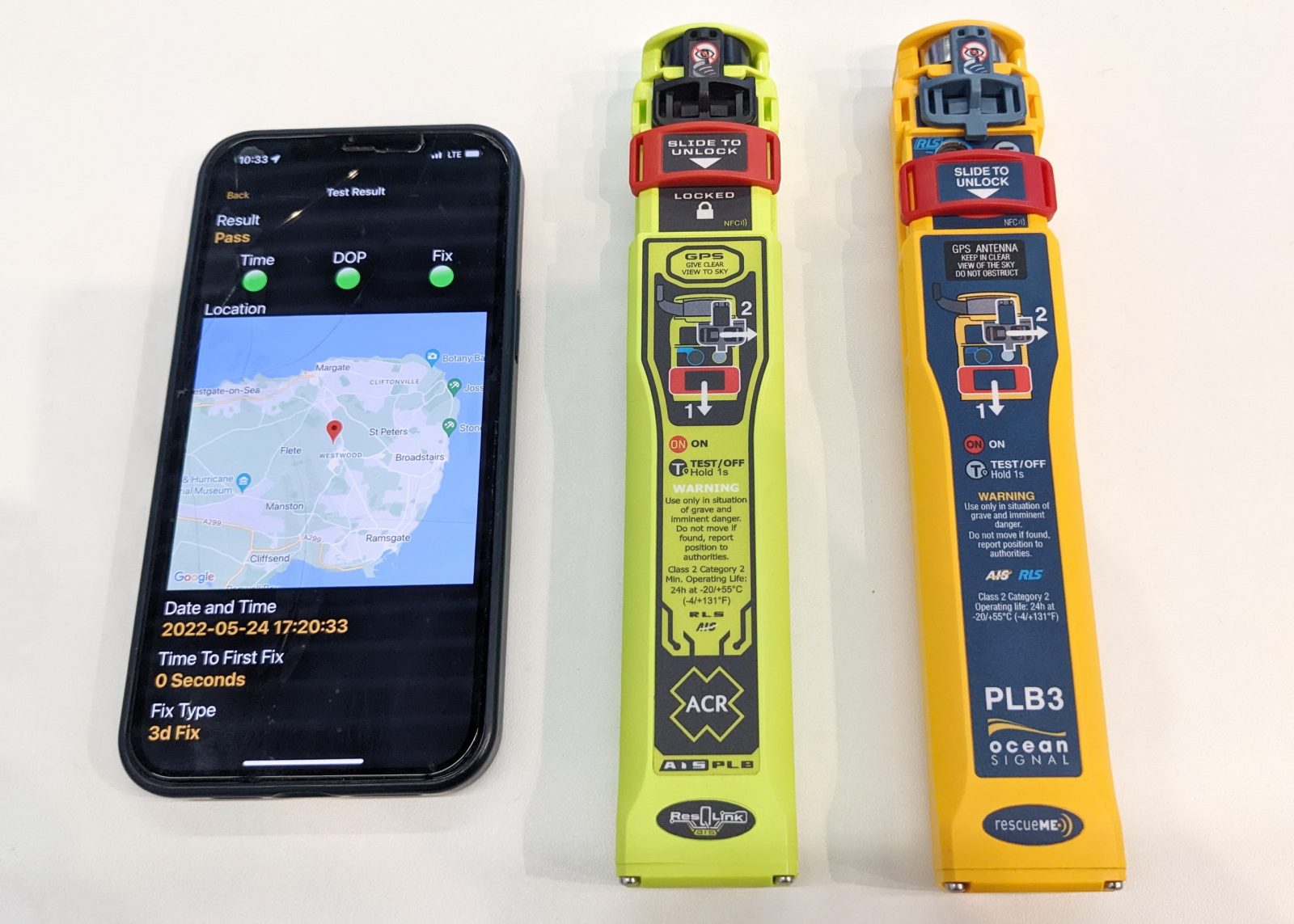
Hallelujah! ACR recently began shipping its ResQLink AIS PLB to customers in the U.S. and the Americas. Meanwhile, the company’s sibling UK brand Ocean Signal has been offering the same remarkable technology to the rest of the world since November as the RescueMe PLB3. The beacons are exactly the same except for color — as shown in my METS demo photo above — and regardless of the possibly confusing dual branding, I call them a huge advance in marine safety
The ACR and Ocean Signal engineering teams did not just add the local rescue features of an AIS personal beacon to a state-of-the-art global rescue 406 MHz PLB, though that’s a truly significant accomplishment. They also squeezed in yet another communications protocol — called NFC for Near Field Communications — to support a smartphone app that greatly improves on the regular testing a wise mariner uses to remain confident about the beacon’s capabilities throughout its long service life.
Moreover, they applied the same advanced engineering to new EPIRB models for each brand, as I’ll discuss after detailing the wonders of these NFC RLS AIS PLBs.
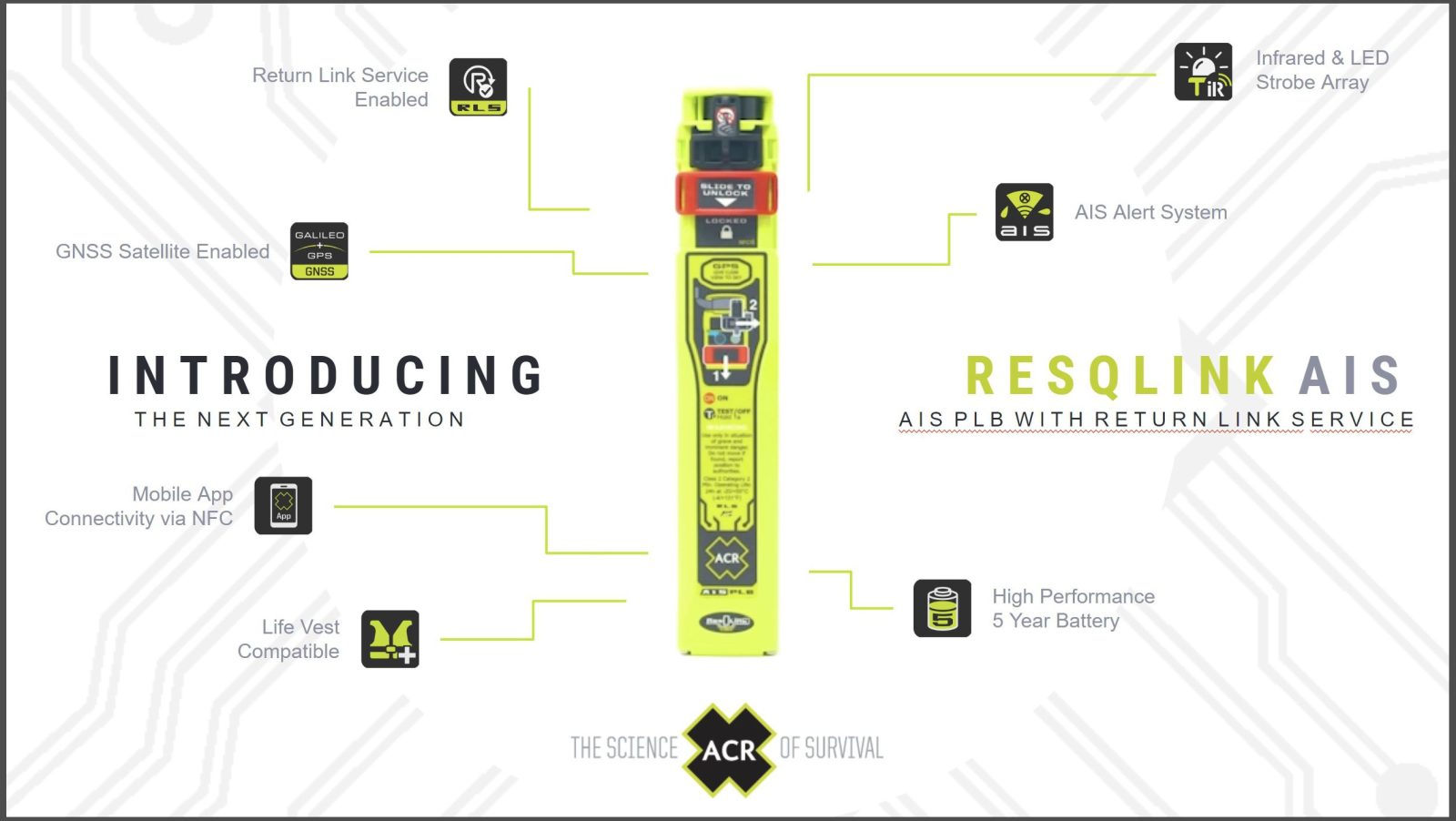
Yes, there are many acronyms involved in these next-generation Personal Locator Beacons. And there are at least two reasons to understand them. The obvious one: The more familiar you are with a safety device you hope not to use, the more smoothly it’s apt to work for you when the going gets tense. Second, readers indecisive about replacing or abetting their existing safety beacons may appreciate how many advancements have come together in these new models.
So let’s break down what the ACR ResQLink AIS PLB and the Ocean Signal RescueMe PLB3 can do.
Cospas-Sarsat global rescue with RLS
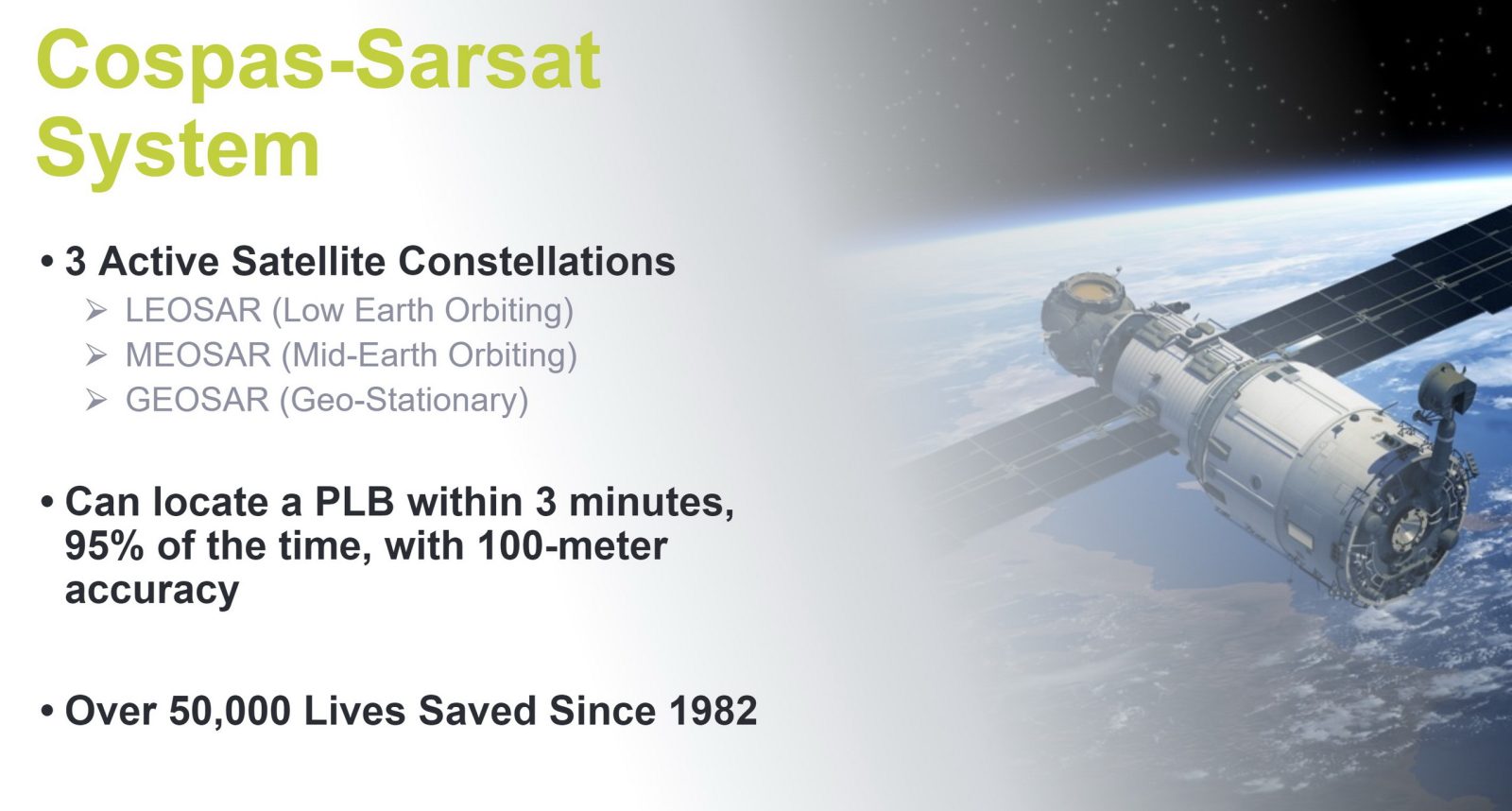
The international Cospas-Sarsat system of satellite-mounted 406 MHz distress signal receivers, ground stations and rescue services just celebrated its 40th anniversary, with a record of success so solid that many boaters almost take it for granted that a subscription-free PLB or EPIRB built to the Cospas-Sarsat standard will just work. Actually, in recent years the system has improved in at least two significant ways.
Now that GPS is only one component in the Global Navigation Satellite System (GNSS), PLBs and EPIRBs that can receive locating signals from multiple satellite constellations can get faster and more accurate fixes. The new ACR / Ocean Signal PLBs, for instance, can acquire up to 72 GPS, Glonass, and Galileo channels simultaneously, which is valuable for quickly fixing position from a cold start in what may be difficult reception conditions.
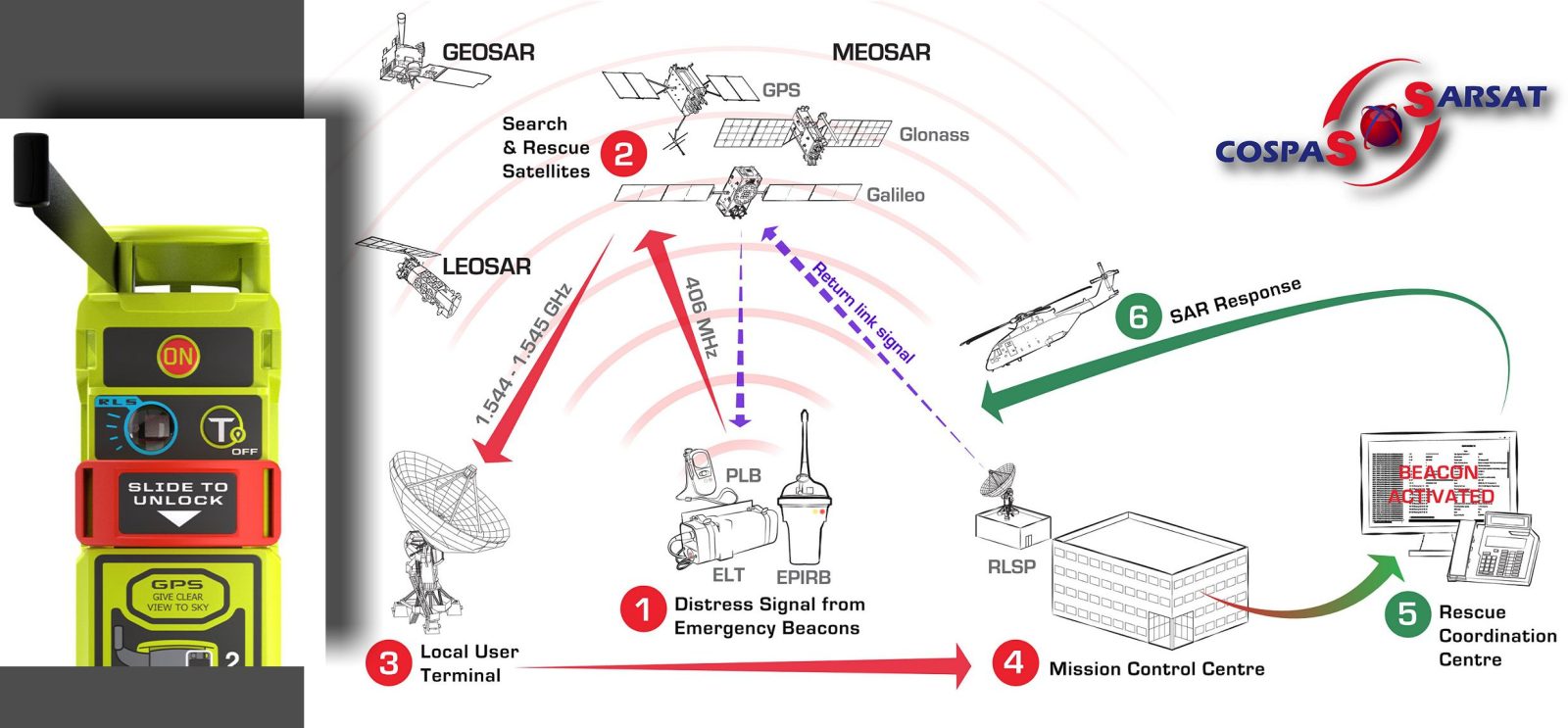
Compatibility with the Galileo Medium-Earth Orbit Search and Rescue (MEOSAR) system also means that the AIS PLB / PLB3 design supports the relatively new Return Link Service (RLS), whereby a flashing blue LED can inform the person(s) in distress that their localized signal has indeed reached the Cospas-Sarsat ground station network. It’s a great feature when you realize that before RLS, a person or boat in distress did not know if their PLB (or EPIRB) worked until rescuers actually showed up (unless they had another form of communication).
ACR and Ocean Signal were arguably late to RLS given that I wrote enthusiastically about the first RLS PLB in 2019. Then again, getting individual countries to update ground stations and to permit RLS turned out to be a long process, and even NOAA Sarsat needed prodding. So in hindsight, ACR seemed admirably conservative, only offering its first RLS PLB models in the U.S. last June. And the global RLS situation looks even better today.
For example, in December the EU Space Program announced new Galileo SAR infrastructure in the Indian Ocean (that adds redundancy to the global RLS system) and even had a real-time RLS event to brag about. That was when Golden Globe Race participant Tapio Lehtinen activated a PLB from his liferaft, was geolocated by Cospas-Sarsat in 4 minutes, and received an RLS acknowledgment 15 seconds later.
(Lehtinen’s personal survival lessons is a valuable read, and the GGR’s multiple redundant safety gear requirements are especially admirable given its fascinating goal of “Sailing like it’s 1968.” It’s also neat that Lehtinen’s rescuer Kristen Neuschäfer holds the lead with over 25,000 miles under her keel.)
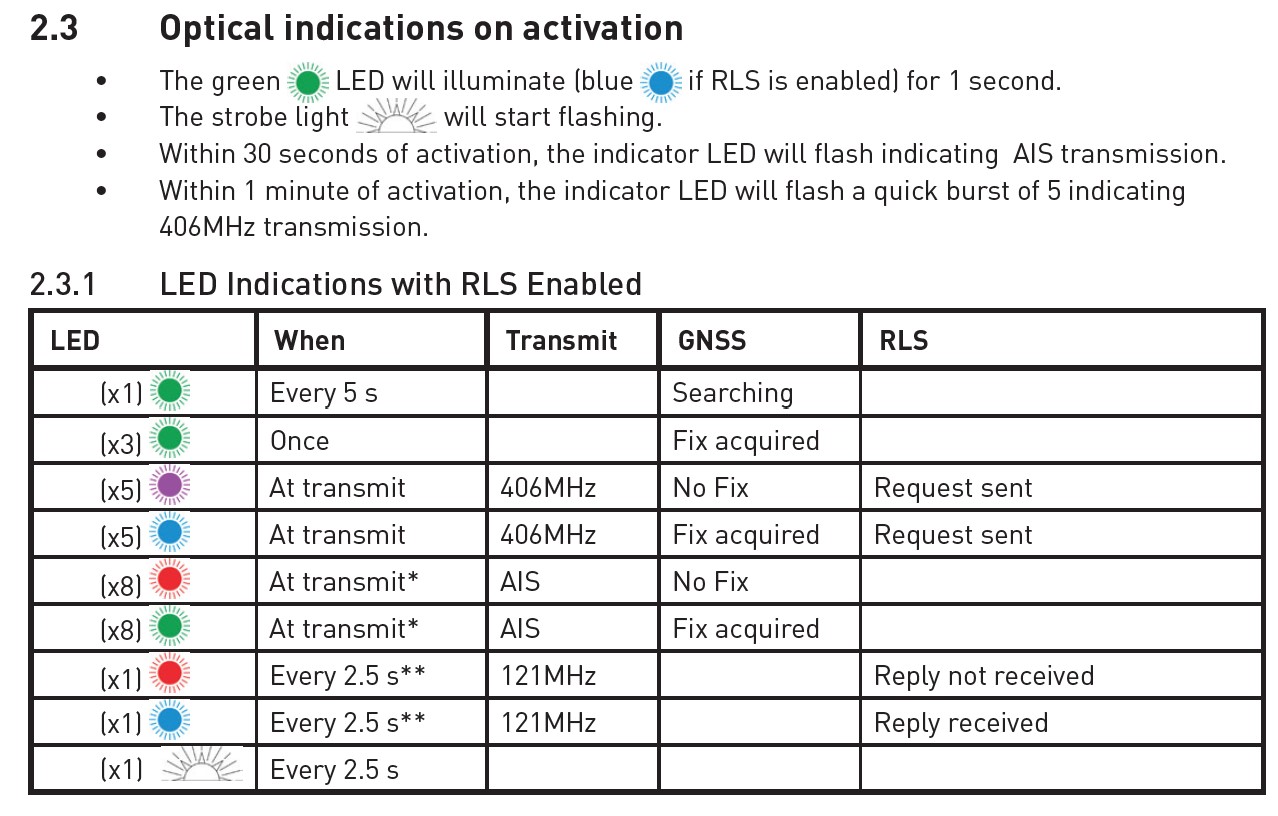
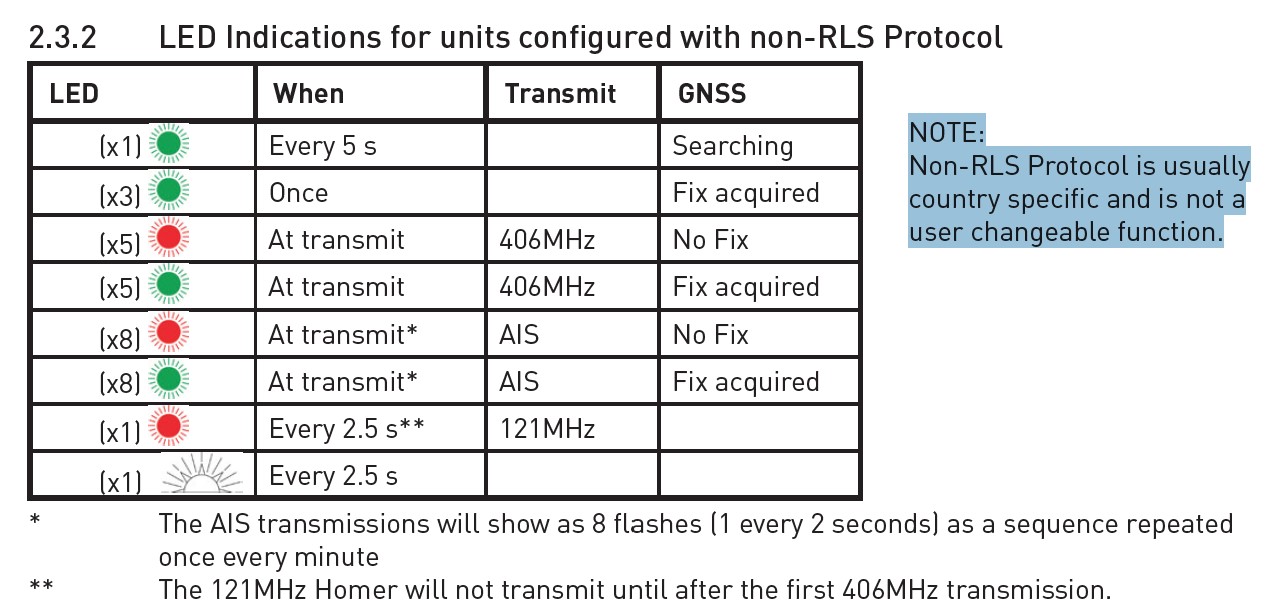
That said, some countries still do not authorize RLS use, as indicated in the official Cospas-Sarsat list. Note some surprises like how Germany supports RLS for EPIRBs (and aviation ELTs), but not for PLBs. Note too that a beacon like the ACR AIS PLB will come with RLS disabled if the protocol is not yet supported by the country where it is purchased, as shown in the manual screenshots above and as stated on the beacon’s label.
I don’t want to overstate this potential limitation, but buyers in some countries should take heed. Also, to be clear, an RLS-enabled beacon will purportedly receive a Return Link anywhere it’s used, though sometimes with a delay.
AIS beacon too

While RLS helps with one shortcoming of PLBs and EPIRBs — did they hear me? — another remains: If you fall off a boat with a PLB, the boat won’t be alarmed and can’t track your position. Moreover, if you activate either type of Cospas-Sarsat beacon on a boat in distress, nearby vessels won’t know it unless the SAR authorities get in touch (or you use other means like flares or VHF).
That’s why it’s such a great idea to add an AIS transmitter to an EPIRB, and especially to a PLB. And while it’s a special variant of the overall Automatic Identification System, the same personal AIS beacon technology has been maturing for over a decade, and has proven itself quite effective.
Also called AIS SARTs, AIS MoB beacons, or AIS MSLDs (in standards language), devices like the ones I tested above transmit at 1 Watt, sending eight position messages per minute — four on each AIS channel — in such a way that at least one goes out on the highest point of a wave. This has often allowed boats to track and retrieve persons overboard, has also worked in nearby boat-to-boat rescue situations, and was notably useful to Jean Le Cam’s amazing Vendee Globe boat-to-liferaft save.
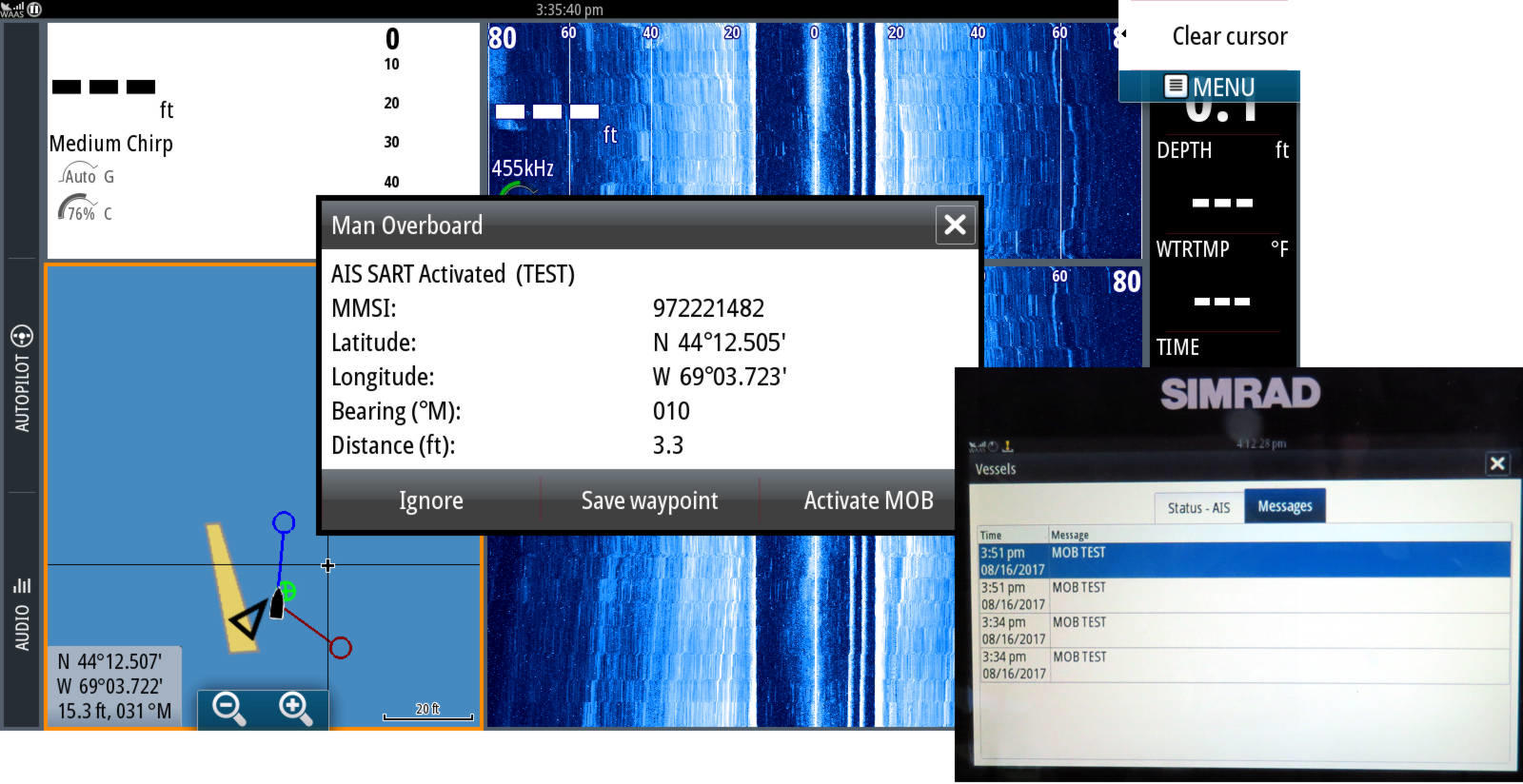
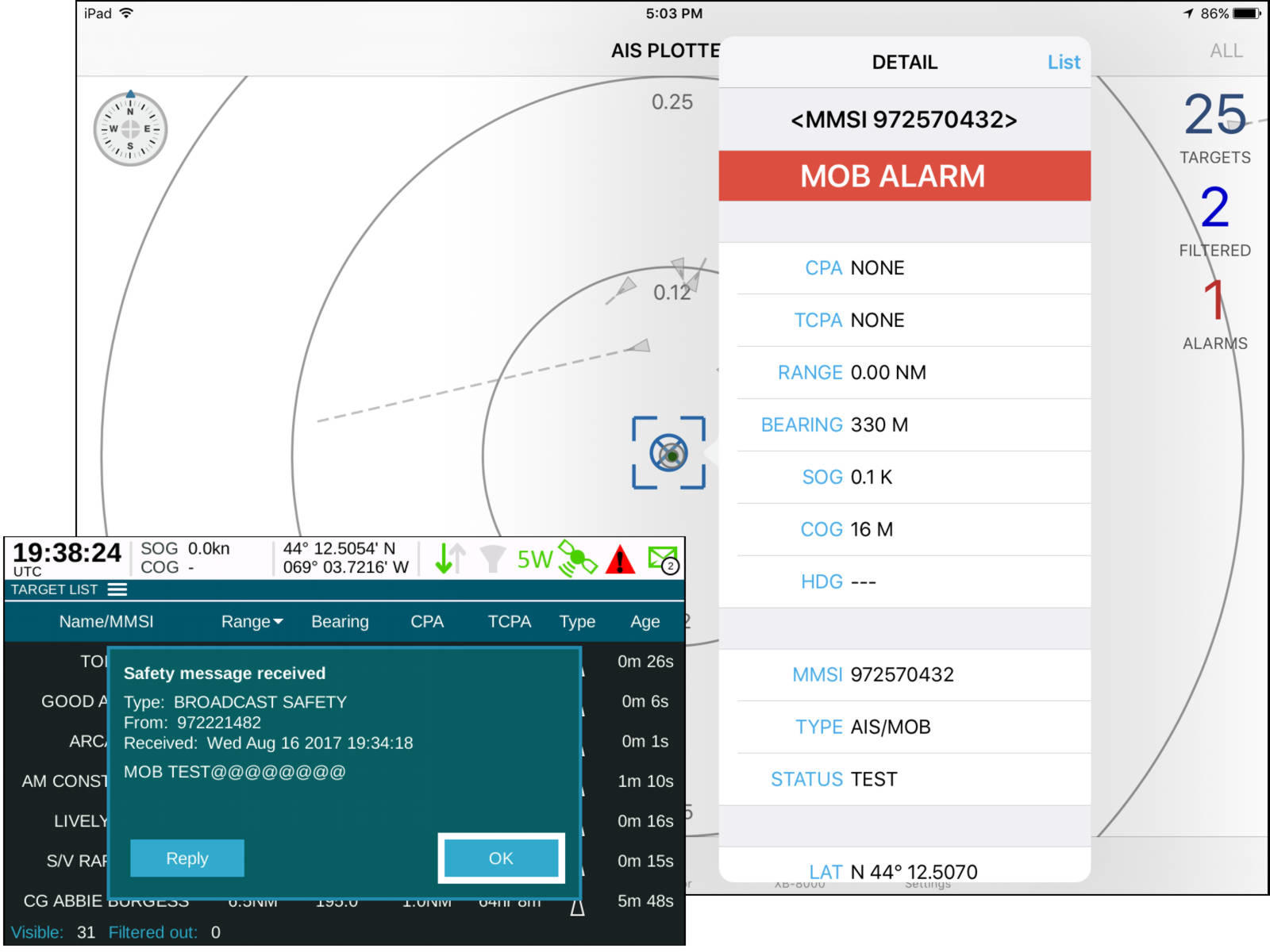
It took a while for chart plotters and even dedicated AIS target plotters to recognize AIS beacons properly, but nowadays we can expect these new PLBs (and EPIRBs) with AIS built-in to set off alarms and establish rescue go-to waypoints on most any display that plots AIS targets.
Moreover, you can test it on your own boat’s displays — as shown in the screenshots above — because the AIS beacon technology that Cospas-Sarsat now permits in their satellite beacons includes a live AIS test signal. But, wow, the bigger testing news is what ACR and Ocean Signal have done with their NFC app.
The NFC App
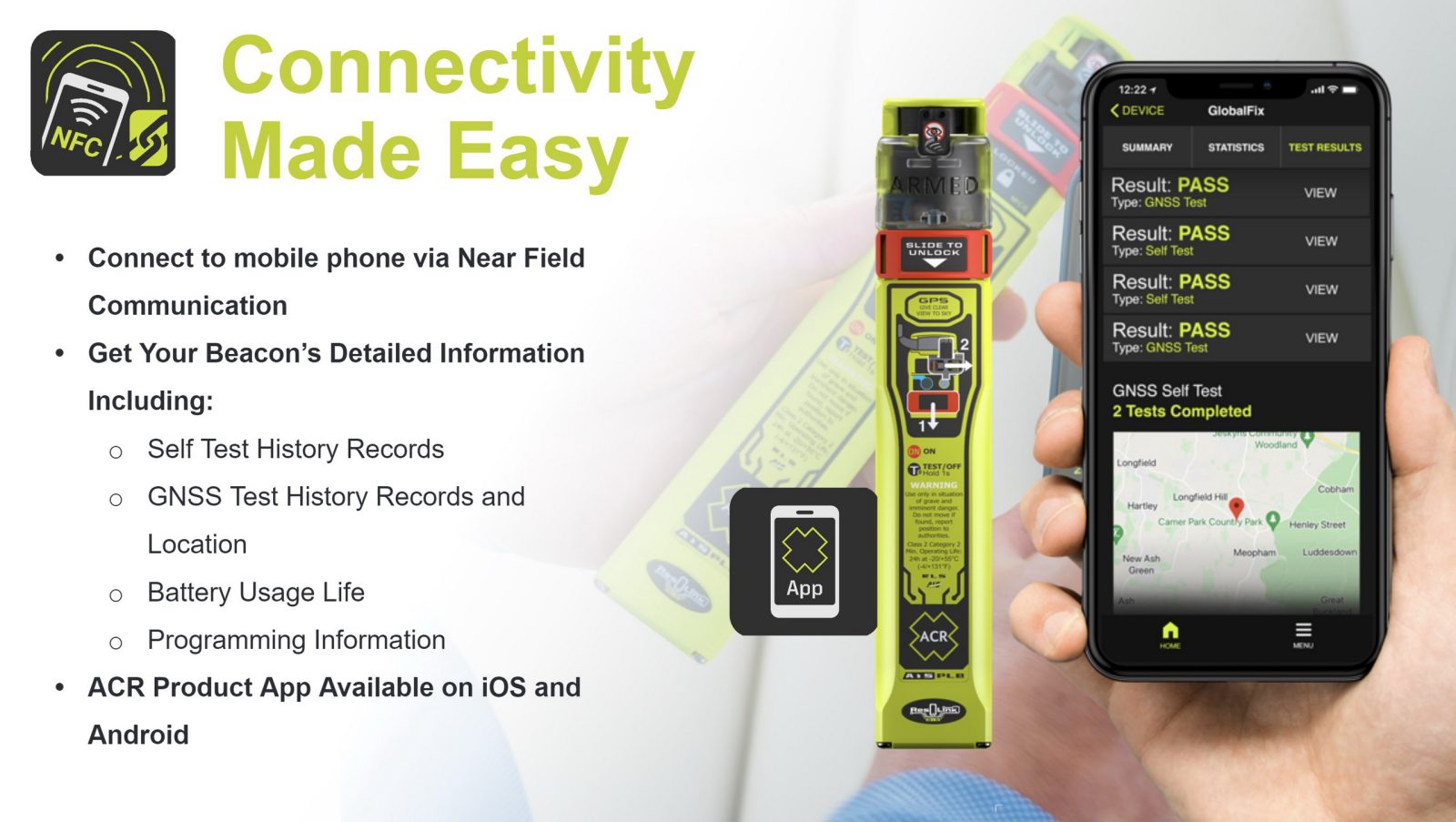
Frankly, I was a bit skeptical about the ACR/OS beacon app when it was first teased last fall, wondering if it was just a gimmick. But that worry vanished quickly when I saw it demonstrated at METS. The app can already display and database more detail about beacon testing and usage than previously possible, and thus it can clearly track the device’s battery status. And thanks to the nature of Near Field Communication, using the app has no effect on that battery.
I also appreciated how the app is not used to initiate a beacon test. Instead, you set up a regular Self Test or full GNSS Test using the PLB’s controls — which is good practice — and then later tap your phone on the beacon’s NFC spot to add the results to the app.
Moreover, the ACR/Ocean Signal representative helped me realize that once the beacon(s) are connected to the app running on your pocket computer, and hence to the cloud, many more useful features are possible.
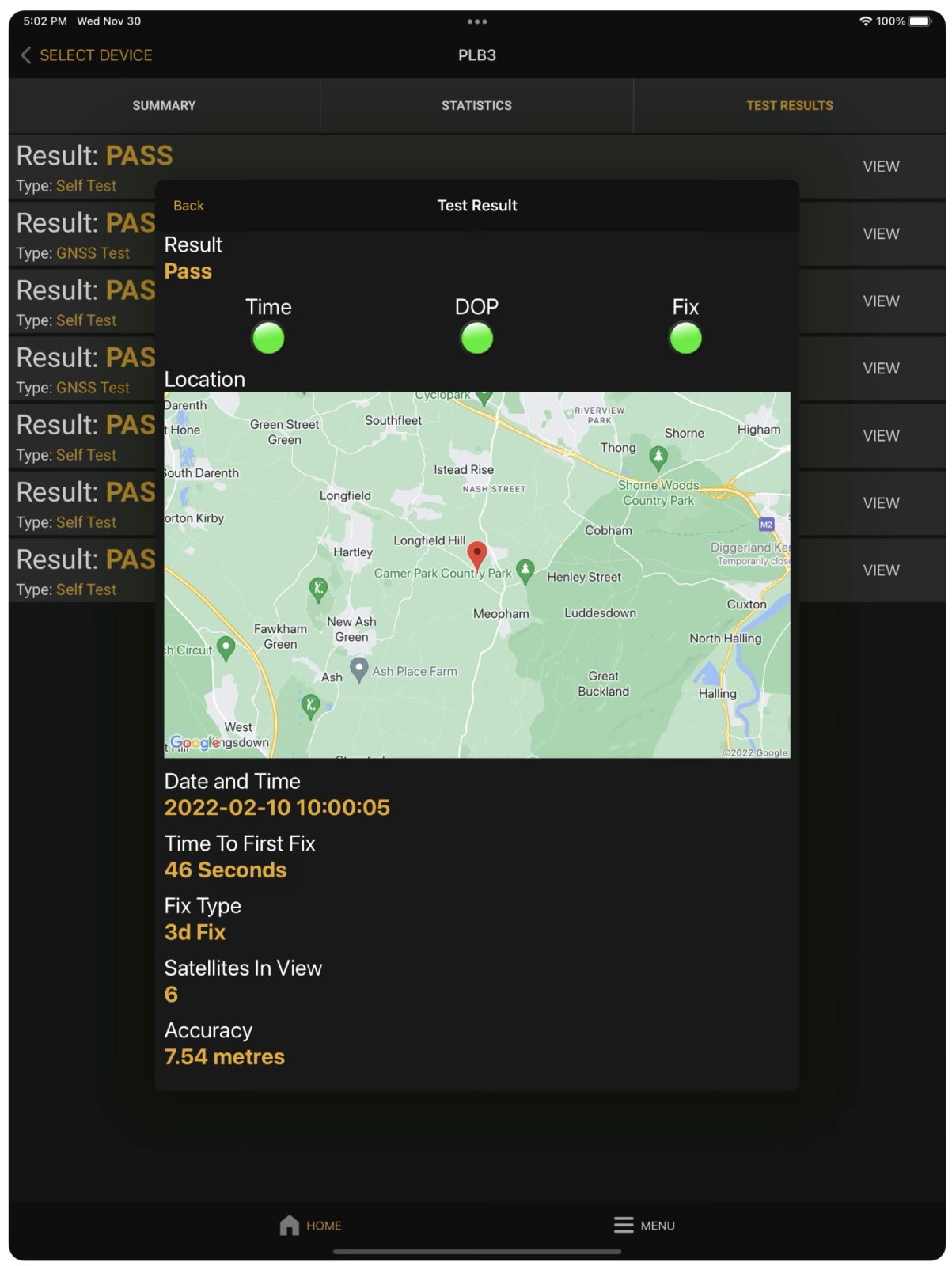
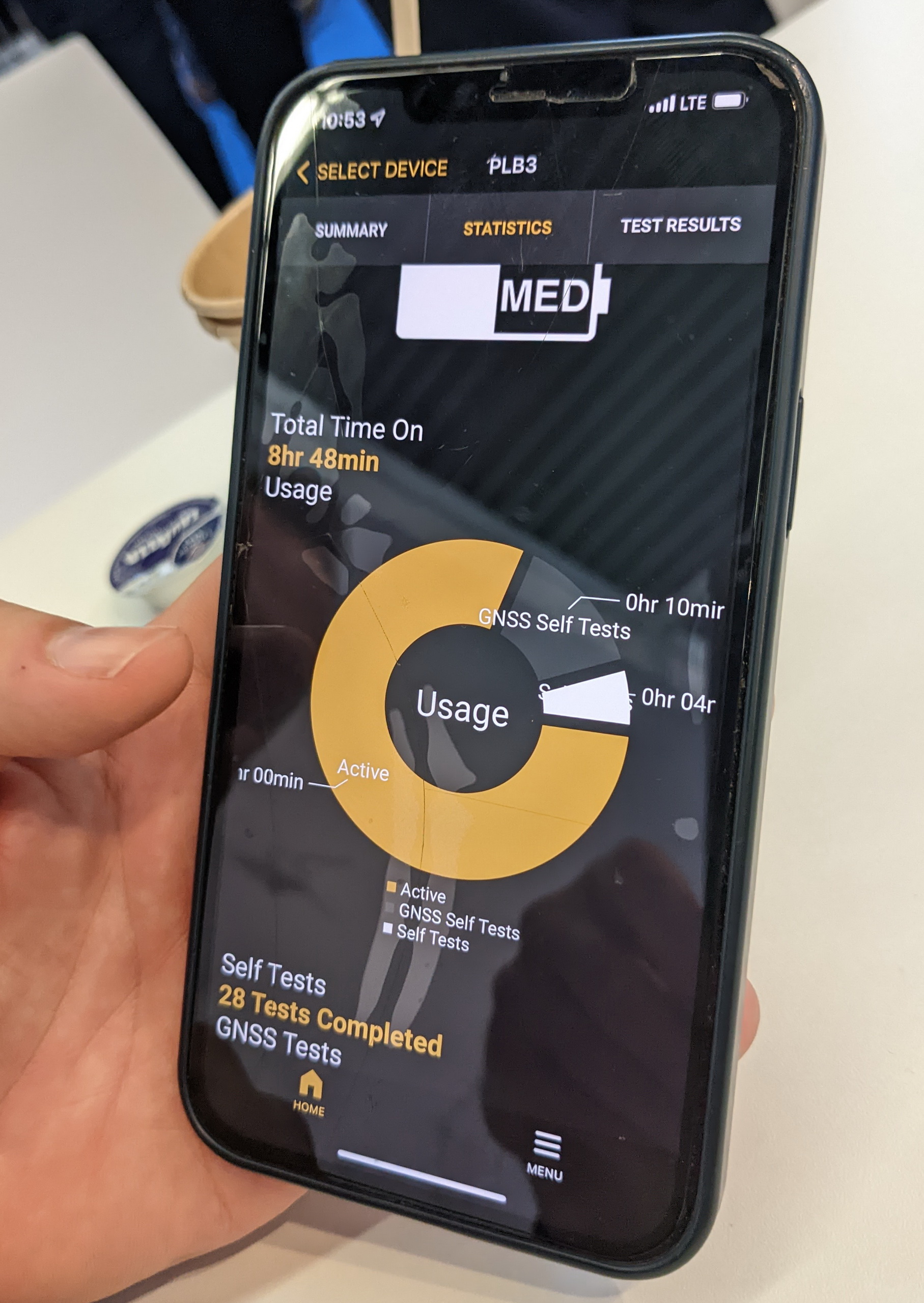

In fact, the PLB and EPIRB NFC beacon management features were added to an existing app that can already configure Class B+ AIS transceivers like the ACR AISLink CB2 or the Ocean Signal ATB1 via WiFi. So I suspect that future ACR and Ocean Signal products will also be supported by the app, and given the low demands of NFC that might even include small items like rescue lights.
It’s also easy to visualize possible future app features like reminders about testing intervals and easy access to your online beacon registration. Note that monthly beacon testing is recommended and the new ACR / OS AIS PLB supports up to 60 of the more power-consuming GNNS test during the battery’s five-year lifetime (which is also the beacon’s warranty period).
Also note that while 406 MHz beacon registrations must be renewed every two years, you can modify emergency contact and beacon use details online at any time. And that sharing current and complete information with the SAR folks is a good idea, as discussed here.
Incidentally, if you’d like to check out this app yourself, search the Google or Apple stores for “ACR Config” or “Ocean Signal” (though it seems to be same app with different branding).
AIS NFC EPIRBs too
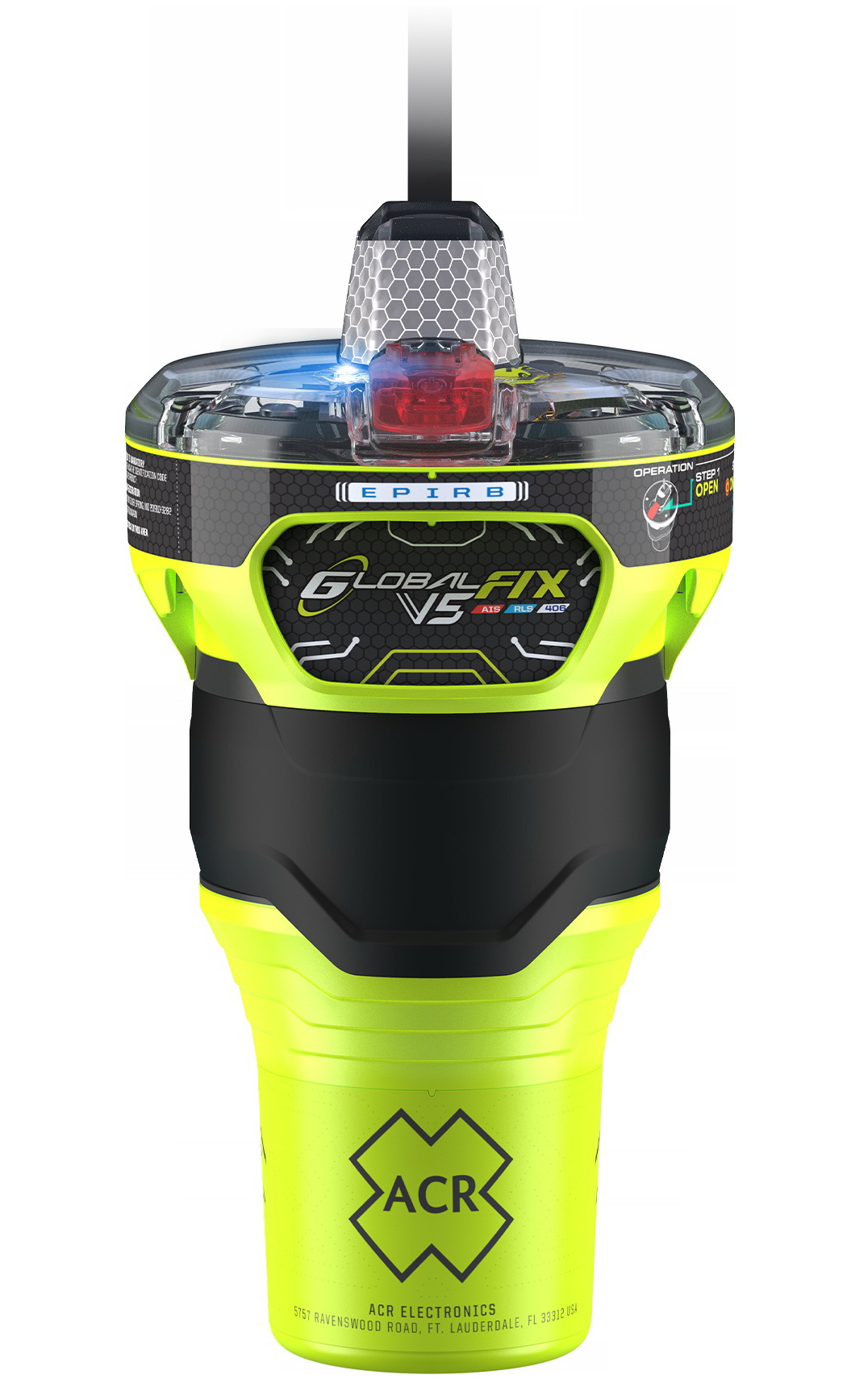

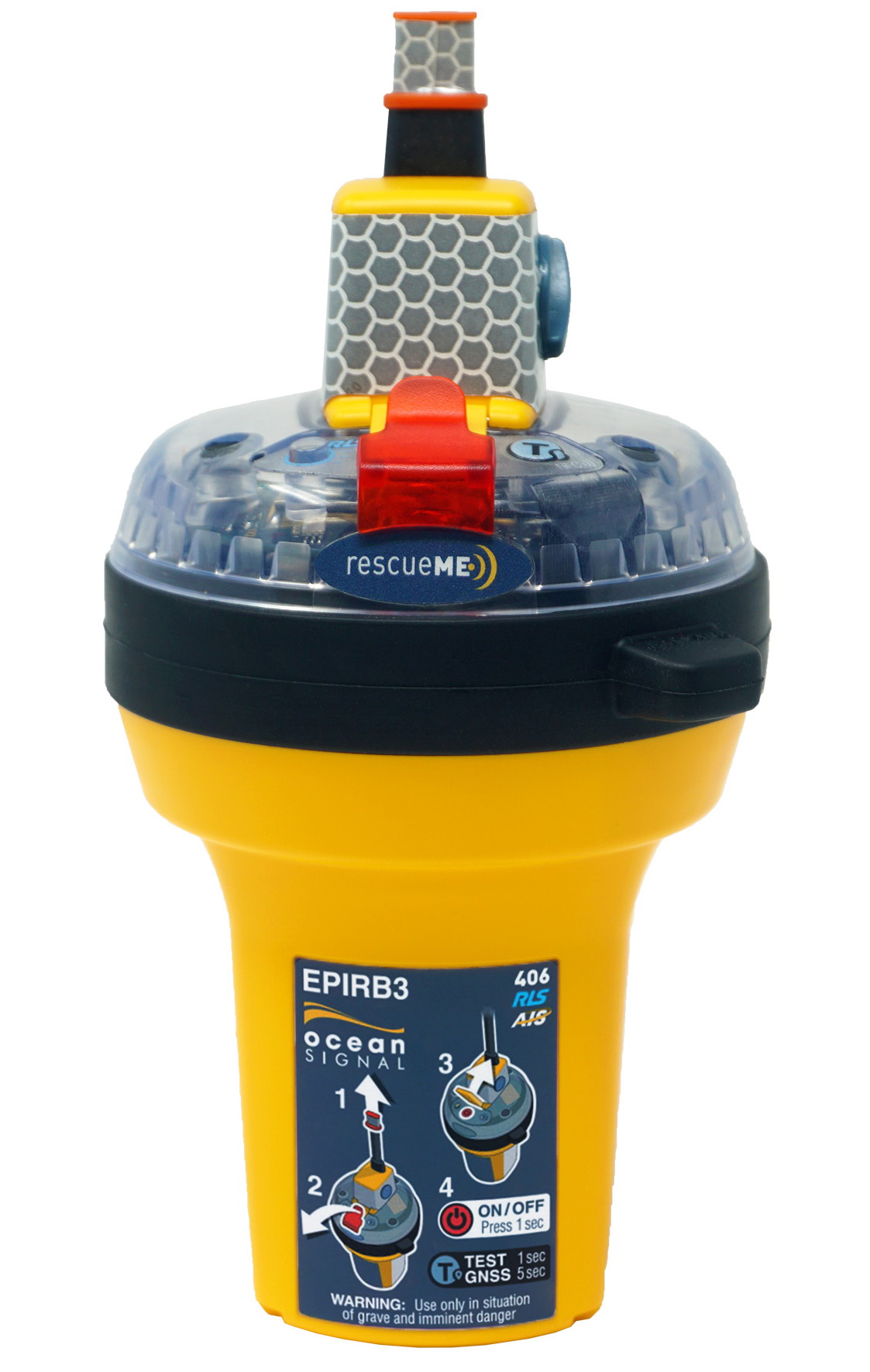
So while the ACR / OS NFC app will be useful to someone who just owns one of the new AIS PLBs, imagine the benefit on a well-equipped yacht that may carry at least one EPIRB and a couple of PLBs. To that end, the companies have introduced four new EPIRB models, all with NFC and other improvements, but only the more expensive ACR GlobalFix 5 and Ocean Signal EPIRB3 with AIS.
Note that besides the new EPIRB multi-channel GNSS and RLS features already discussed in regards to the new PLBs, all the beacons also have a combination white and infared LED strobe light, the latter quite useful if the search and rescue assets or nearby civilian vessels are using thermal vision to find you. But unlike the PLBs, the new ACR and Ocean Signal EPIRBs will all be sold worldwide and while they are quite similar, color is not the only difference. Mainly, from what I can tell, the OS EPIRB2 and 3 series are noticeably more compact than the ACR V6 and V5 equivalents.
Note too that, like existing EPIRBs, these new models have batteries that will stay activated for at least 48 hours while lasting unused for 10 years (testing excepted). That’s double the power performance of the new AIS PLB batteries, and perhaps the main difference between these two 406 MHz beacon types. So is a PLB good enough to carry on a boat as the main safety device? I’ll get to that, but first let’s discuss how well the new AIS PLB design can replace the two personal rescue beacon technologies it includes.
One personal beacon or two?
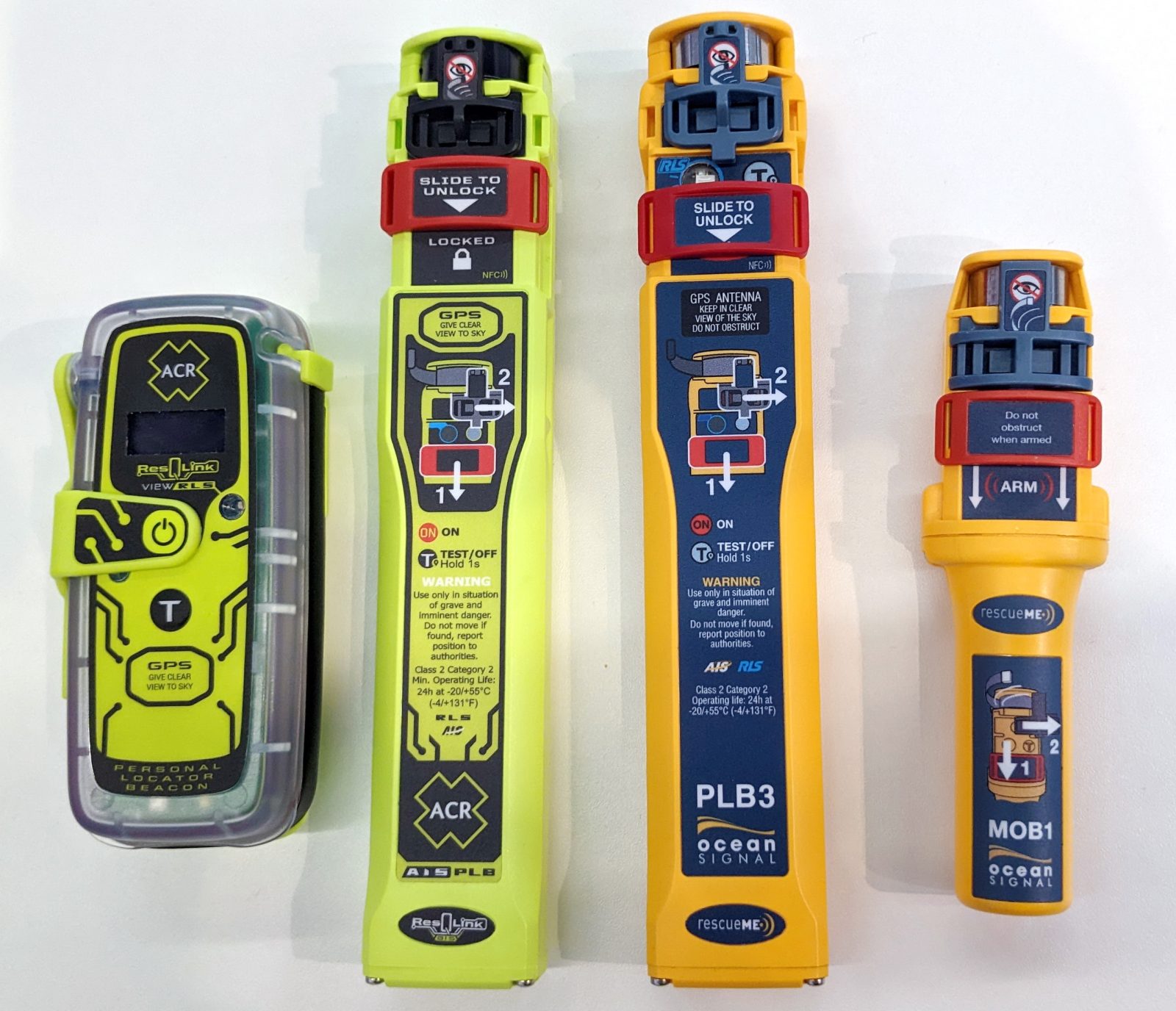
At nearly eight inches tall, the new ResQLink and RescueMe AIS PLBs are arguably more cumbersome to carry on your person than a conventional PLB or personal AIS beacon. In fact, some PLBs are even smaller than the ResQLink View seen at left above, though it includes a little scrolling digital display that is more informative to a user in distress than a multicolor blinking LED (my testing here).
There are also conventional PLBs with batteries that last seven years, and some personal AIS beacons include a DSC VHF alarm feature — tested here — that can really wake up the crew on the boat you just fell off.


But ACR tells me that the new AIS PLB fits inside almost every model of inflatable life jacket (and it comes with accessories that automate beacon activation upon inflation). And while hanging the tall PLB from a belt looks awkward to me, I suspect that a neck lanyard will work fine. In short, it’s hard to see how an individual PLB or AIS beacon with minor extra features outweighs the combination design.
Final thoughts

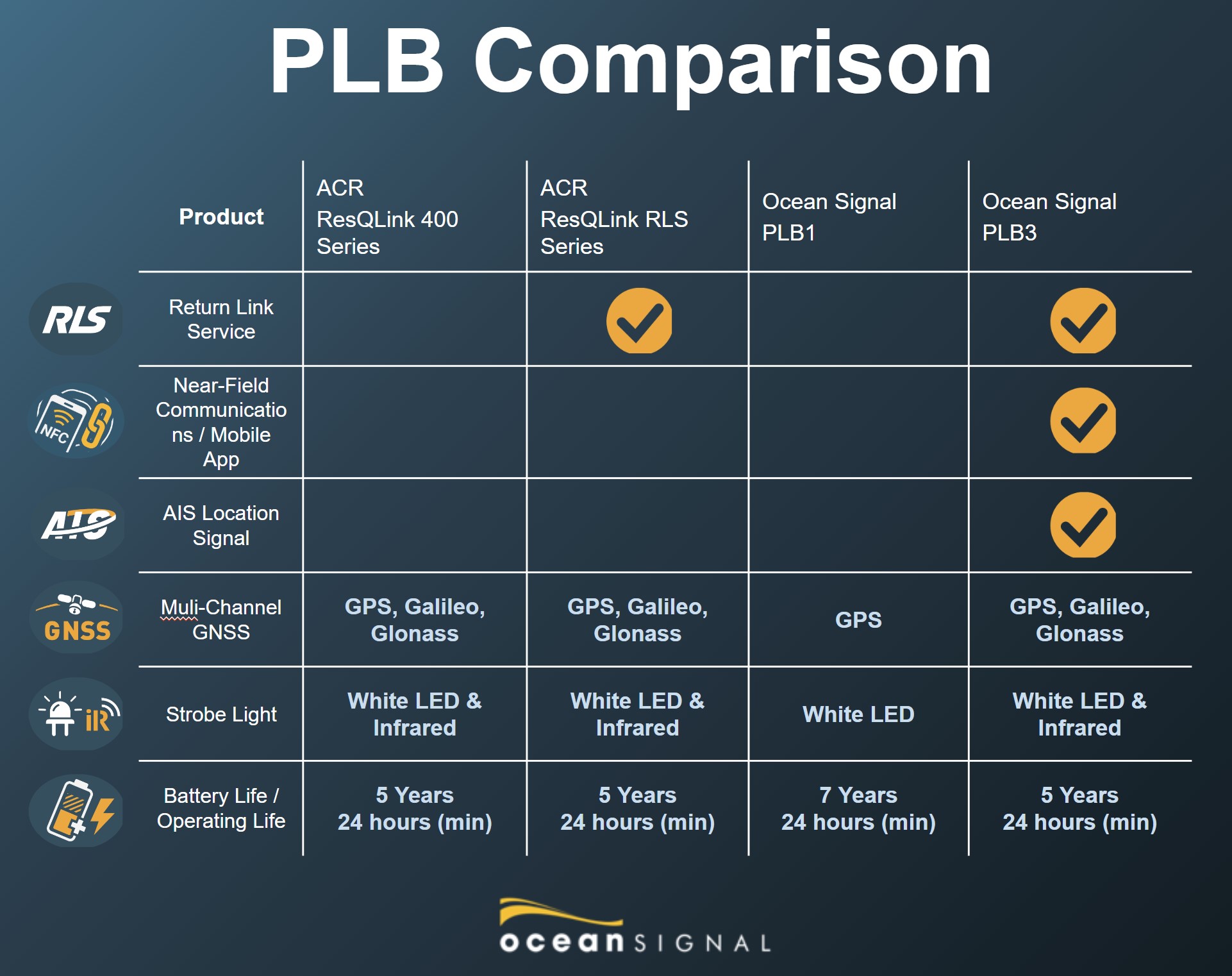
The ACR AIS PLB, also known as the ResQLink 450, retails for $500 while the Ocean Signal PLB3 sells for roughly equivalent prices outside the Americas. And I think that’s a reasonable value, especially considering the cherries-on-top extras like RLS and the NFC app. It’s also less than the total cost of individual PLB and AIS beacons, and I believe in having both forms of distress signal if you fall off a boat, or if something goes wrong on a boat, even if it has an EPIRB.
Actually, having read many descriptions of real distress situations, I think it’s prudent to have as many forms of emergency communications as possible. And I certainly include VHF radios as well as SENDs like the Garmin inReach, ACR’s own Bivy Stick, and — tentatively at least — the slim satellite features rapidly getting added to smartphones.
But while I acknowledge that an EPIRB — especially an AIS EPIRB with category 2 self-deployment — is the best Cospas-Sarsat beacon for a well-funded vessel, I personally carry PLBs and SENDs aboard Gizmo instead. After all, I’m coastal cruising without a liferaft, and a PLB works just like an EPIRB except for that extra day of activation. Plus I really value handheld safety devices that I can take along while exploring a remote island, or anywhere else my phone may fail.
These are personal choices, but perhaps we all agree with 2023 Miami Innovation Award judge Jennifer Brett when she said in praise of the ResQLink AIS PLB: “For many boaters, an AIS-equipped personal locator beacon was the holy grail of safety equipment.” Meanwhile, the RescueMe PLB3 won both the safety category and the overall 2022 Dame Award at METS, and I can attest that the decision was not hard.
So what do you all think? Is there an NFC RLS AIS PLB or EPIRB in your future, or maybe you’re already getting acquainted?


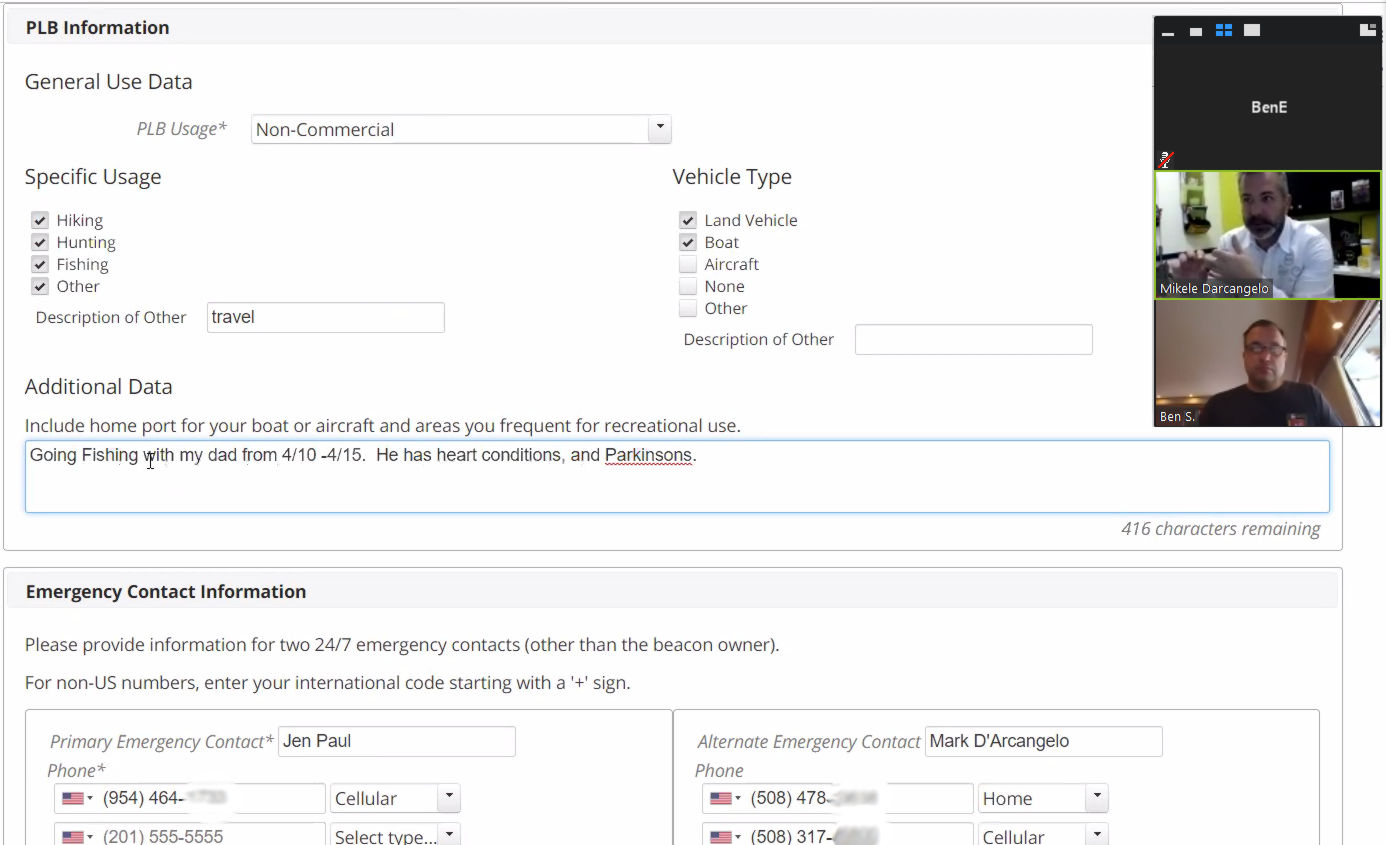


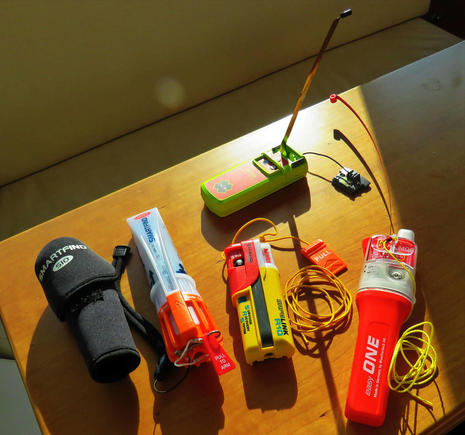







As I was saying about having multiple means of communication when the sh*t hits the fan:
https://www.washingtonpost.com/travel/2023/03/20/sailboat-hits-whale-pacific-rescue/
Raindancer’s VHF and EPIRB were the first defense, but an Iridium GO with PredictWind and a Spot tracker were also involved in the rescue, and even Starlink according to this Loose Cannon report:
https://loosecannon.substack.com/p/whale-sinks-youtube-sailors-mid-pacific
I chaired the Innovation Awards at the Maimi International Boat Show where we awarded the PLB’s innovations in the safety category. I also got to see both units in the flesh. ACR’s Mikele D’Arcangelo can be seen holding the award recipient in the above photo. I’m looking forward to getting my hands on a unit and getting to test the application functionality further. I’m hoping never to test the distress signalling capabilities.
-Ben S.
Great post! While I love the PLB3 feature set, in discussing the device via email with a technical sales manager at Spinlock and with the owner of a major US sailing / safety equipment retailer, both advised that the PLB3 would be a very tight fit for a Deckvest PFD and both advised against expecting that the device would work in this application. But neither had actually tried fitting one as of the time they offered that advice. Until we see that it actually fits we’re holding off on buying them.
Thanks for letting readers know, Adam. Now I recall from METS that ACR told me the PLB3 fit every lifejacket they tried with the exception of some Spinlock models. I guess the tradeoff is a lifejacket design that’s especially compact and easy to wear even for extreme deck work:
https://www.spinlock.co.uk/en-GB/uk/categories/lifejackets
I’ve had an ACR AIS PLB for about a month and testing has gone well. For instance, my second GNSS test showed that a 3D fix was attained almost instantly with accuracy estimated at below a meter, and that was inside Gizmo’s main cabin, though below a large forward window. Also, the AIS portion of the test set off appropriate alarms and test MoB routines on the boat’s Vesper Cortex and Simrad GO5.
I did have trouble with the app, however. Though it had worked fine on my Android phone during initial tests, last week it showed an odd error message and failed to upload more recent tests and usage info from the PLB. Also, ACR tech support was slow to respond and then only kicked the issue to the app developers, who I never heard from. However, a new 2.3.3 version of the Android app just auto-updated on my phone and works fine, no testing or battery usage data lost.
I want to emphasize that the beacon itself seems to work exactly as promised. But my experience is a reminder about how adding an app to a relatively small volume and lightly used marine product can go awry. It’s obvious now that the “ACR Product App” v2.3.2 update was auto-applied to my phone about two weeks ago although it had a bug few users may have noticed. Note that v2.3.2 of the Ocean Signal Android app had the same problem, and apparently so did the iOS version of the app, now corrected in v1.7.5 (which I have not tested because it turns out that no iPad model includes the required NFC communications).
At any rate, I plan some more testing, including auto-activation by lifejacket inflation, and then an entry about how to get familiar with this amazing safety technology.
Auto activation of the ACR AIS PLB by lifejacket inflation worked the first time, and I had fun with my patient brother-in-law at the same time:
https://youtu.be/RcS0G-AMN7E
The removal of DSC is such a shame as that activation would wake everyone onboard very quickly!
Also a shame that the non user replaceable batteries don’t last as long as Ocean Signal claims. We’ve lost a number of these units to dead batteries within a couple of years.
To OS’s credit, they have always offered to replace the battery but that can be difficult in remote locations.
Hi! I require a small clarification.
I recently purchased a ResQLink AIS PLB.
I have carried out the self test and GNSS test with pass results on both.
I wanted to check, if during these tests the device actually shows up on the AIS? Or if that is only going to happen when the PLB is deployed for real (i.e. not in testing).
Thank you
Hi Srikumar. Yes, when you did the full GNSS test, the beacon should have transmitted the AIS MoB / SART test message. I’ve seen it work several times with the ACR AIS PLB (same as yours) that I’m testing, and had several devices on my boat like Vesper Cortex, Simrad NSS, and Furuno TZT2 recognize the signal as an AIS MoB beacon test and plot its position. But that didn’t happen until the very end of the test when the beacon had a valid GNSS position. Examples of what you should see toward the bottom of this entry:
https://panbo.com/testing-ais-mob-beacons-acr-dsc/
Hi Ben, Thank you for the response. I just tried the GNSS test, it is logging in the app (PASS) for me, However, there is no information on the AIS (Furuno) or Chart plotter which gets the feed from the AIS. I tried the test twice both times it passed and is logged in the application on my smart phone, just that I cannot see the message on the AIS, do you have any idea If I am missing something?
Well, MoB beacon AIS is a low power signal and I think that the test message with position may only get sent once, but I’ve had a high rate of testing success with numerous beacons over the years. In fact, I tested my ACR AIS PLB inside my boat’s cabin with the AIS antenna directly above, though only about 12 feet away. Are there any nearby boats that can check their AIS when you do a test, or do you know someone with an AIS beacon you could test on your boat? If possible, I’d try one of those options before contacting ACR technical support or the dealer you purchased the beacon from.
PS I don’t know the age and model of your AIS or plotter, but even if they are old and were never programmed to recognize AIS beacons, they should still show a standard AIS target right where you tested.
Note that beacon development is not stopping with AIS PLB’s like these. At METS, MRT showed sMRT Alert AIS MoB beacons that include VHF DSC in a way defined by a new Class M standard that’s becoming mandatory in some countries, as well as an NFC testing app similar to the ACR / OS app discussed above :
https://www.mrtsos.com/commercial/products/emergency-distress-beacons/smrt-alert
They also showed a prototype sMRT Shield+ AIS PLB with all the ACR/OS features discussed above plus Class M DSC. The sMRT Alert should become official pretty soon, but I don’t know the sMRT Shield+ will become available. I also don’t know which VHF radio models properly respond to a Class M DSC MoB alert message.